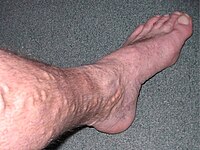
Photo from wikipedia
BackgroundCatheter ablation has become the first line of therapy in patients with symptomatic, recurrent, drug-refractory paroxysmal atrial fibrillation. Circumferential pulmonary vein ablation is still the standard approach in these patients.… Click to show full abstract
BackgroundCatheter ablation has become the first line of therapy in patients with symptomatic, recurrent, drug-refractory paroxysmal atrial fibrillation. Circumferential pulmonary vein ablation is still the standard approach in these patients. The occurrence of an atrioesophageal fistula is a rare but life-threatening complication after such ablation procedures. This is due to the fact that the esophagus does frequently have a very close anatomical relationship to the left or right pulmonary vein ostia. The aim of our study was to evaluate whether the exclusion of areas adjacent to the esophagus does have a significant effect on the success rate after circumferential pulmonary vein ablation.MethodsTwo hundred consecutive patients [121 men, 69 women; mean age 59.1 years (SD ± 11.3 years)] with symptomatic paroxysmal atrial fibrillation underwent a circumferential pulmonary vein ablation procedure (using the CARTO- or the NAVX-system). In 100 patients, a complete circumferential pulmonary vein ablation was attempted regardless of the anatomical relationship between the ablation sites and the esophagus (group A). In the remaining 100 patients, the esophagus was marked by a special EP catheter and areas adjacent to the esophagus were excluded from the ablation procedure. After discharge, patients were scheduled for repeated visits at the arrhythmia clinic at 1, 3, 6, 9, 12, 24 and 36 months after the ablation procedure.ResultsThe ablation procedure could be performed as planned in all 200 patients. In group A, all pulmonary veins could be isolated successfully in 88 out of 100 patients (88%). A mean number of 3.9 pulmonary veins (SD ± 0.37 PVs) were isolated per patient. The 12 cases of an incomplete pulmonary vein isolation were due to poorly accessible pulmonary vein ostia. In group B, all pulmonary veins could be isolated successfully in only 58 out of 100 patients (58%; P < 0.01). A mean number of 3.5 PVs (SD ± 0.6 PVs) were isolated per patient (P < 0.01). This was mostly due to a close anatomical relationship to the esophagus. The ablation strategy had to be modified in 46/100 patients in group B because of a close anatomical relationship between the right (n = 25) or left (n = 21) pulmonary vein ostia and the esophagus. One year after the ablation procedure, 87% of patients in group A (87/100) and 79% of patients in group B (79/100) were free from an arrhythmia recurrence (P = 0.19). Three years after catheter ablation, the success rate was 80% (no arrhythmia recurrence in 80 out of 100 patients) in group A and 66% in group B (no arrhythmia recurrence in 66 out of 100 patients; P = 0.04). There were no major complications during long-term follow-up.ConclusionsThe exclusion of areas adjacent to the esophagus results in a markedly higher percentage of incompletely isolated pulmonary veins after circumferential pulmonary vein ablation procedures. This results in a significantly higher arrhythmia recurrence rate during long-term follow-up.
Journal Title: Clinical Research in Cardiology
Year Published: 2017
Link to full text (if available)
Share on Social Media: Sign Up to like & get
recommendations!